|
I have put this page together as a to serve as
a guide for the selection of Exterior and Interior door hardware.
Included is an explanation of commonly used terminology along with some
diagrams and links which
I hope you will find useful. It is my intention that this write up helps
to acquaint you with the differences between the various types
of available hardware. If you you are preparing an order and should have
any questions I will be glad to walk you through the process.
Jeff Balazs Owner & Craftsman
Commonly used door Terminology
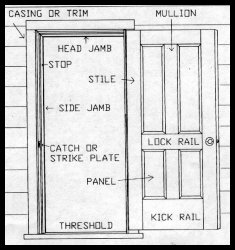
A commonly seen diagram explaining handing :
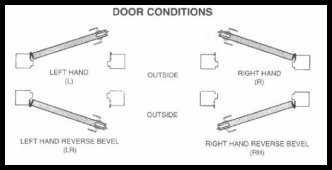
Determination of Handing
Handing is the first item which needs to be determined to order door
hardware. It is used to determine hinge placement and jamb configuration
and plays an important part in lock selection. It is also an area that can
cause some confusion due to the variety of ways our language is used. I prefer
to use terminology such as "Left Hung, Open In" for exterior
applications as I believe that it is a more accurate way to describe the conditions.
Most Exterior residential doors swing to the inside of the home. Only
a small percentage swing out. The accuracy of this description becomes a very
important consideration when ordering mortise type lock sets. Per the diagram
above there are four possible configurations, each requiring a different
lock set. For interior mortise lock applications this number
drops to two. Handing is slightly less significant with knob to knob (or
tubular) type lock sets as they are generally a universal type application.
One exception to this is that certain designs of lever type handles are
handed and must be ordered accordingly.
When determining handing of an Interior door you should always look at
the door from the hall side. Interior doors typically swing into a room
and never into the hall. One exception to this rule is walk-in closet or
pantry type doors which should be looked at from the room side. Remember
that some lever type handles are handed and care must be taken when ordering
these.
A set of floor plans or a accurate sketch
showing the door openings can be useful in helping to prevent mistakes.
Selection of Lock Hardware for Exterior applications
For exterior entry systems there are two basic systems
to consider. Mortise lock sets or Knob to Knob lock sets. As you study
the products from different manufacturers you will see that there are many
variations available for each of these basic types. Pay close attention to
the options offered as function and ergonomic features can get confusing.
I have included images of each below so that you can become familiar with
the difference between these systems.
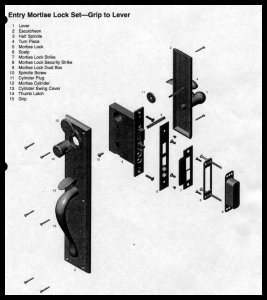
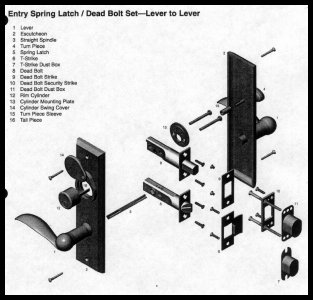
Mortise type Lock Set for an Entry
Knob to
Knob (or tubular)type Lock Set for an Entry
As you can see the lock & latch components are constructed
in an entirely different manner from each other.
The mortise type lock set requires the creation of a large mortise cavity
or pocket within the door stile. It also requires several other different
sized holes which need to be located very carefully. The knob to knob type
set is much less complicated to mount as it only requires a few simple holes
to be bored in the door.
A few points which should be part of your consideration as you select
a lock is the difference in overall appearance and how they actuate, and
the overall ergonomics of each type.
Mortise type sets have a few features that appeal to some homeowners
while at the same time may turn others off. I will start by saying that
if you want to recreate a totally traditional look then the mortise style
is the obvious first choice. This can be seen in the large sculpted handle
and the thumb actuated latch release. For most people this combination epitomizes
the historic look of these lock sets. It should be noted here that the thumb
lever can be a detractor for some people as it may not be a comfortable fit
for their hand and may even cause them some discomfort. Some manufacturers
offer thumb latch tubular sets as well. Another characteristic which may be
of influence is in the manner of how the latch & lock features
are manipulated.
Most all of us are familiar with this function on the knob
to knob style lock set. This becomes a bit more complicated on the mortise
style sets and requires careful adjustment procedures. Whether one is superior
to the other is something that can only be determined by the individual.
One feature of the mortise style set is that it has a more substantial
look and feel than the knob to knob sets.
This carries over into the sound produced when it latch's. I make mention
of this aspect as it is unique to the mortise style lock sets.
One other item of potential interest is maintenance and repair. Depending
on the quality of the manufacturer and the conditions present around your
entry these lock sets may require regular maintenance. Some of the manufacturers
have farmed the machining and assembly of their locks out to overseas sources.
In the case some of the mortise locks now available they do not seem to have
retained the same service life characteristics that the earlier versions
were so famous for. In addition and depending on your mechanical skills you
may need to have
a locksmith perform any required adjustments or maintenance.
The knob to knob style sets also have a set of features associated
with them. The first one is simplicity. They are quite easy to install and
maintain. Next is a lower cost. They are
typically at least $200 less than a mortise type set with similar trim
and function. Next is ease of repair. This feature has a great deal of appeal
to homeowners that wish to maintain
their own hardware. Again a lot depends on the skills of the homeowner
but I think it is safe to say that this type of lock set is significantly
simpler than a mortise lock.
They are typically smaller and look a little less impressive but some
manufacturers have models where this is not so evident. Here again I suppose
that your personal preferences will come into play.
Selection of Lock Hardware for Interior applications
For interior doors you again have a choice between mortise type locks
and knob to knob or tubular sets as they are some times referred to. For
the most part many of the same features and differences exist in the interior
versions of these lock types. As far as function goes there are generally
two variants: Passage and Privacy. Passage sets offer a latching system while
a Privacy set has a locking feature. I have included images of these
locks so that you may readily see the differences.
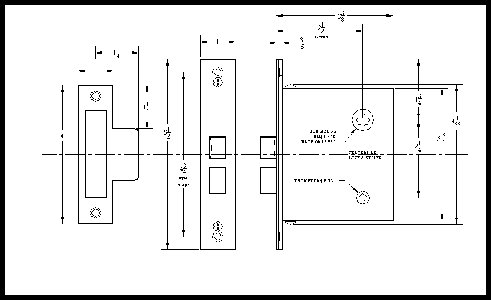 A typical interior mortise style passage and privacy
set
A typical interior mortise style passage and privacy
set
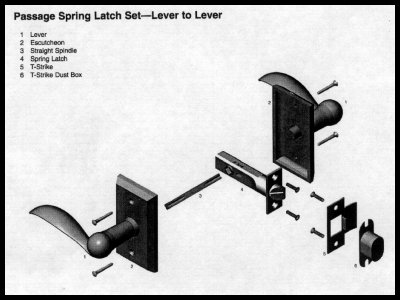
Common tubular type passage latch set
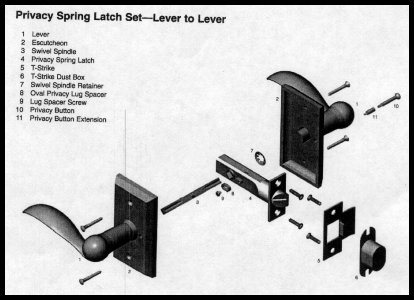
Common tubular type privacy latch set
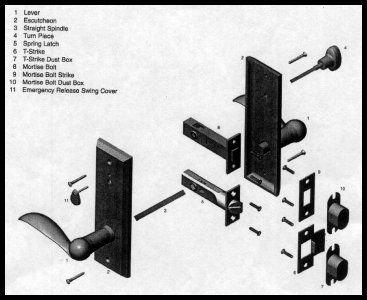
Common tubular type latch and lock set
The knob to knob or tubular sets are used far more commonly
than the mortise type sets. In all the years I have been building doors I
have only fitted mortise locks on a handful of interior doors. Cost again
probably plays a big part in this. Also the visual difference between the
two is much less noticeable than it is in entry applications. I would have
to say that the same set of personal preferences apply to these locks....
mortise type appeals to some customers and the knob to knob type is the right
choice for others.
Set Back
While we are talking about lock selection we should probably discuss
the term "Set back". This term refers to the distance between the center
of the knob, handle or lock cylinder and the outside edge of the door.
For most mortise locks used in exterior applications there are two options.
These are 2 3/4" or 2 1/2" with the first being the most commonly used version.
For knob to knob lock sets the options for "Set back" are commonly
2 3/4" or 2 3/8".
All of the exterior doors that Heart of Oak Workshop produces
feature a 5 1/2" wide stile as a standard. This allows a lock set with a
2 3/4" set back to be centered within the door stile for the best overall
appearance.
Tubular style interior lock sets have the same "Set back" options and
here 2 3/8" is seen quite often as many interior doors have slimmer door
stiles. Quite a lot of doors available for interior use have 4 1/2" wide
stiles. In some instances certain combinations of lock sets and door
stile widths can result in a bad fit. This is particularly true if flipper
type handles are combined with very narrow door stiles. You should make sure
that your lock selection is pretty well thought out before ordering doors
to help avoid this.
Some manufacturers will provide mortise style locks with different set
back dimensions from what I have listed. There is always a fairly substantial
up charge associated with these non standard sets. And a longer lead time
as well.
Hinge Types and Arrangement
There are quite a lot of different
hinges types available on the market these days. I have installed many different
types and have to say that I actually prefer a good quality anodized steel
hinge without bearings as the best all around performer. My standard has
been an oil rubbed bronze finish Hager hinge for more years than I care to
think about. I have tried others but have always returned to these as they
have been generally excellent performers where others have not. They are,
by the way quite inexpensive compared to some of the others and this cost
savings is something I am able to pass on to my customers. I will be happy
to furnish other types of hinges and in different trim and/or finishes if
requested.
Standard hinge arrangement on our doors
is as follows:
Exterior Doors : 3-0 to 3-6 x 6-8 get 4 - 4" x 4" heavy
duty oil rubbed bronze finish hinges
3-0 to 3-6 x 7-0 get 4 - 4" x 4"
" " " "
" "
" "
All doors larger than this get 4 - 4 1/2"
x 4 1/2" extra HD oil rubbed bronze finish hinges
Interior Doors : All 6-8 height doors get 3 - 3 1/2" x
3 1/2" heavy duty oil rubbed bronze finish hinges
or
3 - 4" x 4" for extra wide or heavy designs
All 7-0 height doors get 3 - 4" x 4"
" " " "
" "
" "
or
4 - 4" x 4" for extra wide or heavy designs
All 8 -0 height doors get 4 - 4" x 4" heavy duty oil rubbed
bronze finish hinges
Heart of Oak Workshop uses these configurations and hinge
sizes as a standard. Any planned deviation from these standards should be
determined during the placement of an order. We will be happy to upgrade
or revise these standards on any specific special order at our cost.
Special Door Hardware Items
There are a number of specialty door hardware items
which may be of interest to homeowners. Included are items such as Hold
opens, self closing hinges, Observation devices, Speak Easy's, Draw bolts
& canes, Door knockers, Mail slots, auxiliary locks and several other
such items. Should you wish to incorporate any of these items into your doors
this should be discussed during the placement of your order. In general any
of these can be accommodated into the design of your doors. There are however
a few situations where this may not be practical due to the physical constraints
of a given door design. As an example adding a speak easy or a mail slot
to certain designs which I offer is not physically possible without
dramatically altering the appearance of the door.
Final comments on selection of door hardware
There is a huge range of hardware
available to the consumer these days. In some instances the choices are staggering.
Your choices should be made carefully. There are some products available
which may not stand up to the rigors of daily use. My recommendation is to
stick with reputable manufacturers. I have included links to a few below
that make Arts & Crafts style hardware and that I have experience with.
I am sure that there are others but I can not vouch for their products.
Last year I constructed an entry door for a customer who provided
a mortise type lock set that he had ordered from a source unknown to me.
When he brought it in to have it installed we were both quite shocked. The
visible elements of the set such as the escutcheon and handles were quite
nice..... but the mortise lock itself looked as if it was made using stone
tools. Due to time constraints he decided to go ahead and use it. Believe
me when I say that the workings of this lock were a mess. It took me the better
part of 2 hours to get it to operate and there were several sessions of grinding
and filing involved. Fortunately this lock matched the pattern of one
of the better quality mortise locks so it could be exchanged at a later date.
This is a pretty good illustration of the old idiom " Buyer Beware". I
mention it to make certain that my customers are well informed and that hopefully
they avoid this mistake.
Please allow adequate lead time when ordering your door
hardware. Some selections are available and in stock all the time while others
require several weeks of lead time. This is particularly true if you are
interested in one of the very fine handcrafted sets such as is offered by
Craftsmen Hardware. These types of sets often require 6 - 8 weeks to fill
an order.
Maintenance of doors and hardware
There is
one thing that any homeowner can do to extend the life of an exterior door
and it's hardware. It is very simple and does not require special tools
or supplies. Keep it clean and apply a coat of paste wax occasionally.
To clean a door use mild detergent and water on a clean cotton rag. Avoid
the temptation of using a hose. Never use harsh cleaning agents or solvents
as these can damage both the door finish and the hardware finish. Get the
rag wet and wring it out so that is damp, not dripping wet. Go over the
entire door including the hardware and then wipe it down good with another
clean rag and water only. Follow up with a clean dry terry cloth towel and
make sure not to leave water droplets.
Once the door is dry a coat of Johnson's Paste Wax should be applied
with a clean rag. Let the wax haze over and buff to a deep luster
with a clean cotton terry cloth rag. It is as simple as that. You
will be surprised at how nice your door and hardware looks and regular treatment
like this should extend the life of the finish dramatically. One of my early
entry systems went to the east coast. The homeowner has followed this regimen
and this entry is on it's 8th winter and still shows no sign of finish failure.
Locking mechanisms should be wiped down with a clean rag and
any lubrication or adjustments should be done per the manufacturers instructions.
Frequency of cleaning and maintenance is dependent on site conditions and
weather but should probably be done at least twice a year. Dry Graphite or
graphite based lubricants seem to work best on moving parts.
Links to manufacturers of Arts & Crafts inspired
door hardware
Craftsmen Hardware
: Handcrafted Arts & Crafts Hardware
Baldwin Hardware
Emtek Products
Rocky Mountain
Hardware
FLW
* CFA Voysey * Mackintosh * Mackmurdo * Ellis * Gill * Ashbee
|










